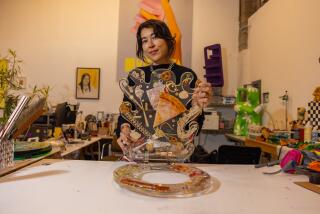The Real Deal in Furniture These Days? It’s Plastic
- Share via
MILAN — You would think it were some sort of wonder material. The way hotshot European designers and furniture manufacturers have taken up with plastic over the last decade--each year more jubilantly--it would seem as though this couldn’t be the stuff of Tupperware and ordinary life.
And the answer is: It isn’t ... and it is.
The plastic that is being molded into “designer” furniture these days, such as at Milan’s furniture fair this spring, represents some of the most cutting-edge advances in science and technology to hit this segment of the furniture world since its heyday in the 1970s.
It was then that manufacturers such as Kartell of Italy started to harness the molding process and more complex plastics to create stylish synthetic furniture that could be mass-produced.
(By definition, just about any synthetic, nonmetallic material that can be molded or shaped is a plastic--and that would include nylon, acrylic, polycarbonate and a whole slew of poly-this or -that.)
But the oil crisis (most plastics being petroleum-derived) dealt fantastic plastic an image problem that way outlasted any shortages. And although Kartell and Magis, another important Italian plastic product maker, never stopped experimenting, there was no groundswell of interest in chic plastic furniture, particularly among American consumers.
Fast forward to the late ‘80s and early ‘90s.
And add big-name designers Philippe Starck and Ron Arad to the picture.
On a mission to bring good design to the masses, Starck created several high-style plastic chairs for Italian manufacturers, who were able to bring them to market for around $150 apiece.
Arad, working with Kartell, performed similar magic with his Bookworm bookshelf--originally done in steel as limited-edition furniture, now refashioned in affordable plastic.
The design world stood in awe. Consumers ate it up. And a plastic revival was born.
These days, everybody who’s anybody in international design is doing something groundbreaking in plastic seating, tables or even cabinetry.
But the plastic they’re working with “has evolved drastically” from the 1970s, according to Ivan Luini, president of Kartell US Inc., whose sales are booming this side of the Atlantic. And now in the retail business as well, Kartell will have six namesake stores selling high-design plastic furniture in the U.S. by year’s end, with talk of two more stores in the works. (Kartell’s collection already is available here at a number of stores.)
“There are plastics now that were not available back then,” Luini continues. Such as: a kind of polypropylene (normally hard and dense like wood) that feels cushy like foam, but isn’t. Last spring in Milan, Kartell introduced a spongy plastic chair made from the techno-polymer.
And there are new production techniques too.
“What I am impressed with in what a company like Magis does or what Kartell does, is that they are using plastic as a noble material”--not as a cheap substitute for something else, says Alan Heller, the uncommon American doing designer plastics.
The molten material allows for shapes and designs that simply could not be done in any other material, says Heller, whose New York-based company works with Italian maestro Mario Bellini and other top European designers to create Modern plastic furniture. Manufacturing is done in Iowa and Italy.
But nodding again to his counterparts overseas, Heller credits the Italian manufacturers for “experimenting with all different sorts of processes” to mold, blow and even spin plastic to new levels of chic.
For instance, the Italians were the first to produce plastic furniture by injection molding, so that a chair or table is formed in one sleek, seamless piece. The process is a careful choreography between hot molten plastic and the rate at which it is injected into a big steel-and-aluminum mold--too slow and the plastic will dry before it reaches the edges of the mold; too fast and it will be uneven.
Rotational molding (previously used to make dolls and soccer balls) is one of the most recent triumphs of the Italian furniture world. It allows for the mass production of large plastic furniture that is hollow and therefore less costly and cumbersome. In a technique similar to the one used to make hollow chocolate Easter eggs, plastic powder is dispersed by centrifugal force through a hot mold that rotates randomly on several axes. After a matter of minutes, the powder evenly coats the walls of the mold--and a chair or sofa is sprung free, holding secret its empty inside.
It was Heller, though, that pioneered the gas-molded plastic chair, using a process previously wedded to the making of small components and plastic bottles.
Simply put, it is “injection molding with gas technology,” explains Heller. The gas “pushes” the molten plastic out of certain parts of the mold, creating vacuous tubes that are both lightweight and strong.
The result: Heller’s now-iconic Bellini chair (introduced in 1998), a Minimalist beauty with delicate legs of fiberglass-reinforced polypropylene. Bellini used the new technology as part of the design process.
The bottom line for most consumers is a lot simpler than all of this, though. It is the fact that plastic is cheap.
Combined with creative technology and design minds that are eager to push the limits, plastic has opened up the chic world of European design to the Average Consumer of Average Pocketbook.
And that, quite frankly, is noblest.
*
The Chicago Tribune is a Tribune company.


